Multilingual Information Resources
Resources to Help Prepare for a Natural Disaster
Japan is a country with a high number of natural disasters, from earthquakes to typhoons. As such, it is always best to be prepared. Below are useful links/tools you can use to make sure you are prepared in a disaster.
Other than these, local City Hall/International Associations also provide more information about disaster preparedness specific to your region, such as where the nearest Evacuation Shelters are, often in multiple languages.
CLAIR offers the following resources free-of-charge:
Translation Point Cards
These cards provide a way of communicating important information as often found necessary at different evacuation sites in times of a disaster.
There are 3 different versions, available to be downloaded together as one file, and how to use them is shown on the first card.
(Card 1)How to use these cards (in Japanese only) and a language check (in all 14 languages)
(Card 2)To be used by staff at evacuation centres (in the languages as indicated below)
(Card 3)To be used by non-Japanese speaking evacuees (in the languages as indicated below)
<Example Images>
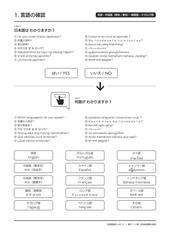
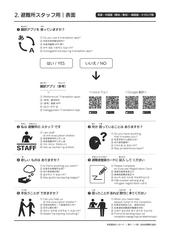
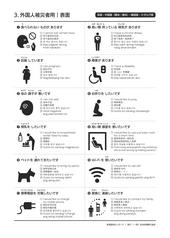
・The cards are available in 14 languages, which have been divided into 3 sets as below:
If you would like to mix-and-match languages, you can do so by downloading the word files and editing them as you would like.
※All sets include Japanese and Plain Japanese.
① English, Chinese (Cantonese & Mandarin), Korean and Filipino ![]() PDF Format
PDF Format![]() Word Format
Word Format
② Portuguese, Spanish, French, Russian, Vietnamese![]() PDF Format
PDF Format![]() Word Format
Word Format
③ Thai, Burmese, Indonesian, Nepalese![]() PDF Format
PDF Format![]() Word Format
Word Format
Evacuation Cards
When evacuating to a shelter, these cards can help you convey your physical condition (if you have any injuries) & needs (e.g. food allergies) in a way that responders/other people can understand, through including Japanese translations and images.
<Example Image (English Version)>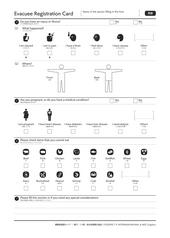
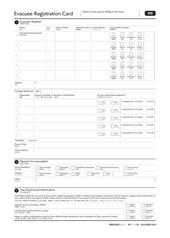
English Version
Multilingual Homepage
Available in 14 languages (English, Japanese, Chinese (Cantonese & Mandarin), Korean, Filipino, French, Portuguese, Spanish, Russian, Vietnamese, Thai, Burmese, Indonesian and Nepalese).
We also offer Food Pict (pictograms), images of common food allergies which can be checked and shown to others to indicate any foods you may be unable to eat.
Multilingual Boards
These boards can be downloaded with different languages according to the needs of the local Evacuation Centre.
They offer commonly-used phrases used for both preparation for and during a National Disaster, both before evacuation and at evacuation shelters, such as "Please Evacuate Now", "Food will be distributed at _:_", and "This is a Drill".
These are offered in a PDF format, or can be downloaded as a Word document.
<Example Image>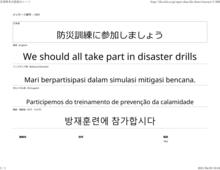
Multilingual Boards Homepage (Japanese Only)
Pictograms
These 24 commonly-used images are offered as PDF files with Japanese, Plain Japanese and English captions.
They can be used in Evacuation Centres and other places where necessary to show certain facilities (e.g. WiFi, bathrooms), rules (e.g. No Smoking) and more.
<Example Images>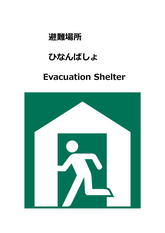
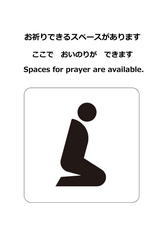
Pictogram Homepage (Japanese only)
Other Useful Websites/Information/Pamphlets, etc.
JMA (Japan Meteorological Agency)
The JMA website provides information regarding weather in Japan, including natural disasters such as earthquakes and typhoons.
NHK World Multilingual Emergency Updates
This portal site provided by NHK World offers up-to-date news and information on various emergency situations in Japan, such as natural disasters. It offers information in 20 different languages, including Japanese, but the amount and type of information may vary by language.
MLIT Disaster Prevention Portal
Provided by the Ministry of Land, Infrastructure, Transport and Tourism, this website provides various information on useful information during a disaster, during daily life, including for preparation, and for travelling throughout Japan.
Disaster Preparedness Tokyo
This online manual, created by the Tokyo Metropolitan Government, is designed to help households get fully prepared for an earthquake directly hitting Tokyo and other various disasters.
"Disaster Preparedness Tokyo" is tailored to the various local features of Tokyo, its urban structure, and the lifestyles of its residents, and contains easy-to-understand information on how to prepare for and respond to a disaster. This information will be both useful now and in the event of an emergency.
"Let's Build Daily Stockpiles"
This pamphlet issued by the Tokyo Metropolitan Government offers lists and advice in what items are necessary to store/prepare in case of a disaster hitting.
Everybody's Manual for Disaster Prevention & Reduction
Issued by the Miyagi Prefectural Government, and also available on CLAIR's Multicultural Tool Library here (Japanese only), this manual provides hints as to how to create a safe evacuation shelter and how to prepare for it, focusing particularly on gender equality and how needs of different genders may differ.
"Do what you can to reduce personal risk ~and an earthquake will not be so threatening~" Reference Book
Provided by the Shiga Prefectural Government, this online book is available in 8 languages, and offers detailed information on how to prepare and react in the case of an earthquake. Also found on our Multicultural Tool Library here (Japanese only).
Emergency Kit Cards
These cards, provided by Shiga International Association (and on CLAIR's Multicultural Tool Library here (Japanese only)), provide a multi-lingual list with images of what items residents of Japan should be keeping in their house in case of an emergency.
Disaster Prevention Points for Residents of Japan
This pamphlet, created by Sakura City, is provided in English, Japanese, Korean and Chinese, and provides information on disasters in Japan, and how to prepare and react to them if they should occur. The final pages are specific to Sakura City, so residents of other areas should search for the Disaster Prevention Maps, Evacuation Shelters and emergency numbers for the area they live in.
Help Card (Also on our Tool Library here (Japanese only))
This help card, created and provided by the Tokyo Metropolitan Government, can be folded into a card-sized piece of paper, making it easy to carry around with you at all times. With emergency phone numbers, phrases in English, Japanese, Korean & Chinese allowing you to communicate in an emergency as well as advice on how to stay safe in a variety of disasters, this Help Card may be very handy to carry with you.
Guide to Using Medical Institutions (Also on our Tool Library here (Japanese only))
This guide, provided in Japanese, English, Chinese, Korean and Vietnamese by the Nagasaki International Association, provides a basic guide on visiting hospitals, what you will need when visiting a hospital, and basic questions asked by most medical facilities in the above languages to facilitate communication. This is not just useful in a disaster, but daily life.
Medical Handbook (Also on our Tool Library here (Japanese only))
This handbook, created by the Ibaraki Prefectural Government & Ibaraki International Assocation, provides detailed translations of various ailments you may experience to allow for smoother communication with doctors, nurses and medical staff if you visit a hospital/clinic. Please note that the final page providing Medical Interpretation Supporters is relevant to Ibaraki Prefecture only, but the rest of the information may be used country-wide.
